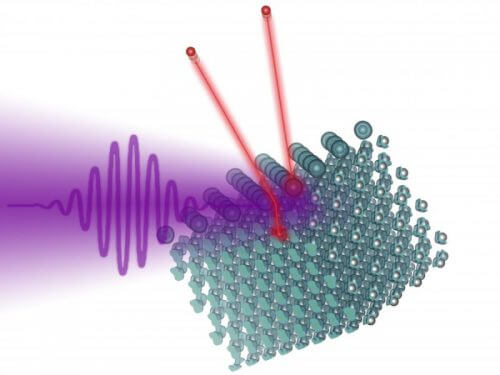A "quantum jump" or in other words, a transition between quantum states occurs almost instantaneously. Now a new measurement method makes it possible to measure the transit time accurately and watch the process. A famous example of a transition between quantum states is the photoelectric effect first shown by Einstein

This is one of the most famous and important experiments of the twentieth century. Light hits a metallic surface and releases electrons from it. No matter how strong the light shines on the surface, as long as the light frequency is not properly calibrated electrons will not be released. Albert Einstein was the first to explain the experiment and thus discovered photons - light particles carrying energy whose magnitude is proportional to the frequency of light.
In the second particle, the electron absorbs the photon and as a result of the energy absorption the electron "jumps" into a new quantum state and is released from the surface. This effect, called the "photoelectric effect", is so fast that for us it happens instantly. Now researchers from Vienna and Berlin were able to measure, using an innovative method, the duration of the effect and observe it during its occurrence. The researchers measured the effect on the tungsten surface and published the findings in the famous journal Nature.
An attosecond of physics
The photoelectric effect is integrated into almost every electronic device - from solar cells, to optical fibers, to mechanisms for opening doors. The effect takes place during an atto second, or in other words a billionth of a billionth of a second. Prof. Burgdorfer from the Institute of Theoretical Physics in Vienna says that "with the help of fast laser pulses, physical phenomena can be observed in this time frame. Together with colleagues from Germany, we were able to measure the amount of time it took for an electron to move from one quantum state to another." Until today we could estimate the duration but not measure it precisely. Now the scientists were able to estimate the absolute duration of the photoelectric effect on the tungsten surface. The new ability to estimate the absolute duration was achieved through multiple experiments, computer simulations and theoretical calculations.
Three atomic clocks
In order to obtain the exact calculation, the researchers followed several steps: first, the electrons torn from the helium were studied with the help of laser pulses. "The helium atom is very simple to model, so we used it to accurately calculate the time it takes for photons to be emitted from the atom. For a complex system like metal, the measurement is considered impossible, not even by the most advanced supercomputers in the world," explained Prof. Lemel.
Now, helium atoms can be used by researchers as precise clocks. In the second experiment, the helium clocks calibrated the iodine clocks. The third experiment was finally able to use the iodine atoms to measure the emission of photons from the tungsten surface. How is this done? The iodine atoms were scattered on the tungsten surface and with the help of short laser pulses that hit the surface, the researchers measured the ratio of light emitted between the iodine atoms and the tungsten atoms - thus they were able to measure the exact duration. It is worth noting that the researchers used tungsten because with the help of the interaction of the electrons with its rim it is easy to measure precisely when the electrons detach from it.
The amount of time it takes for an electron to detach from the surface depends on its initial state. The time range ranges from 100 atto-seconds for electrons located near the nucleus, up to 45 atto-seconds for electrons located in the tungsten shell. But of course the purpose of the experiment is more general and did not focus only on the measurement of absolute time. Now the researchers are opening up to also investigate the transition process between two quantum states and observe new physical phenomena that have been hidden from us until now.
More of the topic in Hayadan:

2 תגובות
I usually don't comment on errors in Hebrew, but you've been writing "correctly" for several articles. FYI, the first Yod is unnecessary.
Ethiopia? The wave function collapses in zero time..